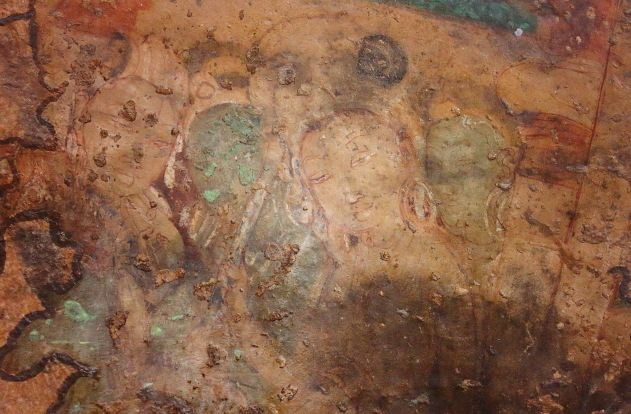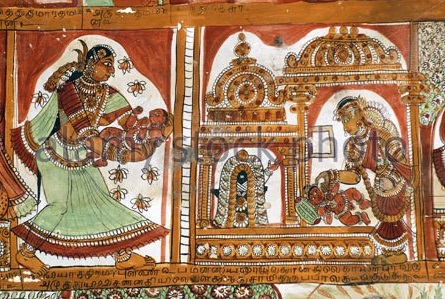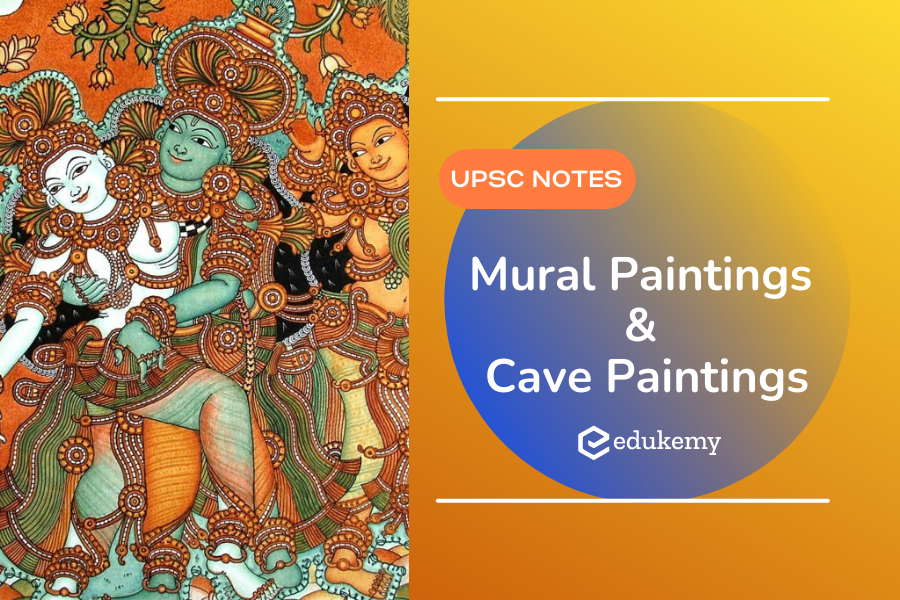
Mural paintings & cave paintings are two distinct forms of art that have played crucial roles in the history of human expression. Mural paintings, often created on the walls of buildings or other architectural structures, serve as vibrant and permanent canvases for artists to convey their messages and stories. These large-scale artworks can be found throughout various cultures and historical periods, offering insights into the artistic, cultural, and social aspects of the societies in which they were created. Mural paintings have been used for a wide range of purposes, from religious and mythological narratives to political propaganda and urban beautification. Notable examples include the intricate frescoes of the Italian Renaissance, the politically charged murals of Mexican muralists like Diego Rivera, and the contemporary street art movement that often uses city walls as its canvas.
In contrast, cave paintings provide a fascinating glimpse into the prehistoric past. These ancient artworks, predominantly found in caves and rock shelters, were created by early humans tens of thousands of years ago. Cave paintings primarily consist of depictions of animals, humans, and abstract symbols. They are believed to have served as a form of communication, possibly documenting the daily lives, hunting rituals, and spiritual beliefs of early human communities. The most famous examples of cave paintings can be found in locations like Lascaux in France and Altamira in Spain, offering precious insights into the creativity and cultural practices of our distant ancestors. Both mural and cave paintings reflect the enduring human impulse to use art as a means of expression and storytelling, connecting people across time and space.
Contents
- 1 Ajanta, Bagh, Sittanavasal, Ellora Caves
- 2 Evolution of mural painting under various empires
- 3 FAQs
- 3.1 Q: What are mural paintings, and where can they be found?
- 3.2 Q: What is the significance of mural paintings in art history?
- 3.3 Q: How old are cave paintings, and where are they predominantly located?
- 3.4 Q: What do cave paintings typically depict, and what is their purpose?
- 3.5 Q: Are there any conservation efforts in place to protect mural and cave paintings?
- 3.6 For Admissions, talk to our Mentor – 9811333901, 9811333782
Some of the places where these murals have been discovered are Ajanta, Bagh, Sittanavasal, Armamalai cave, Ravan Chhaya rock shelter, and Kailashnath temple in Ellora caves. The majority of these paintings are religious and depict themes related to Buddhism, Jainism, and Hinduism.
Ajanta Paintings
- Ajanta is a prime example of painting from the first century BCE to the fifth century CE.
- These paintings primarily focus on Buddhist subject matter, except for the decorative patterns on the ceilings and pillars.
- They are associated with the Jataka, a collection of stories recording the previous births of Lord Buddha.
- Notable specimens
- Cave No. IX and X at Ajanta contain the earliest paintings, of which only one group on the left wall of Cave X has survived. The group depicts a king with attendants in front of a tree decorated with flags. The King has come to the sacred Bodhi tree to fulfill a vow connected with the prince, who is attending close to the king.
- The painting of Bodhisattva Padmapani from Cave I is considered one of the masterpieces of Ajanta Painting. Executed in the late 6th century CE, this beautifully ornamented figure is larger than life and is depicted holding a lotus flower in his right hand while stopping slightly.

- A painting in cave No. XVII, believed to be from around the 6th century CE, depicts Buddha visiting the door of Yashodhara’s abode in the city of Kapilavastu. Yashodhara and her son Rahula have come out to meet the Great King.
- One of the most beautiful depictions of feminine beauty at Ajanta is the painting of Maya Devi, the mother of Buddha.
- In addition to Buddhist paintings, there are also a few Brahmanical figures of iconographic interest. Among them is Indra, a Hindu divinity, shown flying amidst clouds along with celestial nymphs holding musical instruments.
- An example of ceiling decoration from Cave No. XVII, belonging to the circa 6th century AD, features a pink elephant, which is also shown in detail.

Bagh and Badami Cave Paintings
- The paintings located in the Bagh caves of Madhya Pradesh are similar to those in Ajanta’s cave No. I and II.
- Stylistically, both belong to the same form; however, the figures in Bagh are more tightly modeled and have stronger outlines.
- They possess a more earthly and human quality than those found in Ajanta.
- The earliest known Brahmanical paintings are fragments found in Badami caves, specifically in cave No. III, dating back to circa the 6th century A.D.
- A well-preserved painting of Siva and Parvati can be found among the fragments.
- While the technique is similar to that of Ajanta and Bagh, the modeling in Badami is much more sensitive in texture and expression, with a soft and elastic outline.
- The paintings found in Ajanta, Bagh, and Badami represent the classical tradition of the North and the Deccan at its finest.


- The presence of murals in Sittanavasal and other locations in the South highlights the widespread practice of this art form.
- The paintings in Sittanavasal predominantly depict Jain themes and symbols, yet are executed using the same standards and techniques as those in Ajanta.
- These paintings feature well-defined outlines that contrast against a light red background.
- One of the notable decorative scenes on the ceiling of the veranda showcases a stunning lotus pool teeming with birds, elephants, buffaloes, and a young man gathering flowers.
Ellora
- Ellora caves are a group of 34 caves, including 17 Brahmanical, 12 Buddhist, and 5 Jain temples excavated from the living rock between the 8th and 10th centuries CE.
- The Kailashnath Temple is the most impressive, dedicated to Lord Shiva and developed under the patronage of Rashtrakuta king Krishna I.
- Notable specimens include the Buddhist Chaitya cave known as Vishwakarma Cave, themed caves like Raavankikhai and Dashavatara Temple, and two famous Jain caves named Indra Sabha and Jagannath Sabha.
- Overall, the murals and cave paintings in these locations represent the classical tradition of North and Deccan at its best.

Badami cave paintings
- The region of Badami was ruled by the early Chalukyan dynasty from 543 to 598 CE, and it served as their capital.
- An inscription in Cave No.4 dating back to 578-579 CE praises the beauty of the cave and dedicates an image of Vishnu.
- The paintings inside the cave depict palace scenes, including one of Kirtivarman, the son of Pulakesin I and older brother of Mangalesha, seated inside the palace with his wife and courtiers watching a dance scene.
- The paintings found in Badami caves are similar in style to those in Ajanta.
- The fluid forms, sinuous lines, and compact composition of the paintings demonstrate the skill and maturity the artists had achieved in the 6th century CE.

Evolution of mural painting under various empires
Chola Kings
- The Pallava kings, who succeeded the Chalukya kings in parts of South India, were great patrons of the arts. Mahendravarman I, with numerous titles such as Vichitrachitta (curious-minded), Chitrakarapuli (tiger among artists), and Chaityakari (temple builder), showed his interest in art activities.
- The paintings in temples were done at his initiative, though only fragments remain. The Panamalai figure of a female divinity is drawn gracefully.
- Paintings at the Kanchipuram temple were patronized by the Pallava king, Rajasimha. Faces are round and large.
- Lines are rhythmic with increased ornamentation compared to the paintings of earlier periods. The depiction of the torso remains like the earlier sculptural tradition but is elongated.
- When the Pandyas came to power, they also patronized art.
- Tirumalaipuram caves and Jaina caves at Sittanvasal are some of the surviving examples. Here, on the pillars of the veranda, are seen dancing figures of celestial nymphs.
- The contours of the figures are firmly drawn and painted in vermilion red on a lighter background. The body is rendered in yellow with subtle modeling.

- Supple limbs, the expression on the faces of dancers, and rhythm in their swaying movement, all speak of the artists’ skill in creative imagination in visualizing the forms in the architectural context.
- The paintings were executed on the walls of the narrow passage surrounding the shrine in Brihadeshwara temple.
- The paintings show narrations and aspects related to Lord Shiva, Shiva in Kailash, Shiva as Tripurantaka, Shiva as Nataraja, a portrait of the patron Rajaraja and his mentor Kuruvar, dancing figures, etc.
Vijayanagara Murals
- The paintings at Tiruparakunram, near Trichy, done in the fourteenth century represent the early phase of the Vijayanagara style.
- In Hampi, the Virupaksha temple has paintings on the ceiling of its mandapa narrating events from dynastic history and episodes from the Ramayana and the Mahabharata. Among the important panels are the ones that show Vidyaranya, the spiritual teacher of Bukkaraya Harsha, being carried in a palanquin in a procession and the incarnations of Vishnu.
- In Lepakshi, near Hindupur, in present-day Andhra Pradesh, there are examples of Vijayanagara paintings on the walls of the Shiva temple. In keeping with the tradition, the Vijayanagara painters evolved a pictorial language wherein the faces are shown in profile and figures and objects two-dimensionally.
- Lines become still but fluid, and compositions appear in rectilinear compartments.
- The preceding centuries’ stylistic conventions were embraced by artists in different centers of South India, as evidenced by the Nayaka Period paintings.

- The Nayaka dynasty’s paintings from the seventeenth and eighteenth centuries can be found in Thiruparakunram, Sreerangam, and Tiruvarur in Tamil Nadu. In Thiruparakunram, there are paintings from two different periods, the fourteenth and seventeenth centuries.
- Early paintings illustrate scenes from Vardhaman Mahavira’s life.
- The Nayaka paintings depict episodes from the Mahabharata and the Ramayana, as well as scenes from Krishna-Leela. In Chidambaram, there are panels of paintings narrating stories related to Shiva and Vishnu, such as Shiva as Bhikshatana Murti and Vishnu as Mohini.
- The above examples suggest that Nayaka paintings were essentially an extension of the Vijayanagara style with minor regional modifications and incorporations. A good example is the painting of Nataraja at Tiruvalanjuli.

Kerala Murals
- Kerala painters from the sixteenth to the eighteenth century created their pictorial language and technique while selectively adopting stylistic elements from Nayaka and Vijayanagara schools.
- They drew inspiration from contemporary traditions such as Kathakali and kalam ezhuthu, using vivid and luminous colors and representing human figures in three dimensions.
- The artists also drew from oral traditions and local versions of the Ramayana and the Mahabharata for painted narration.
- Over sixty sites have been discovered with mural paintings, including three palaces: the Dutch Palace in Kochi, the Krishnapuram Palace in Kayamkulam, and the Padmanabhapuram Palace.
- The mature phase of Kerala’s mural painting tradition can be observed at sites such as the Pundareekapuram Krishna temple, Panayanarkavu, Thirukodithanam, Triprayar Sri Rama temple, and Trissur Vadakkunathan temple.

FAQs
Q: What are mural paintings, and where can they be found?
A: Mural paintings are large-scale artworks typically created on walls, ceilings, or architectural structures. They can be found in a variety of settings, including public buildings, churches, museums, and even on outdoor walls in urban areas.
Q: What is the significance of mural paintings in art history?
A: Mural paintings have played a significant role in art history, serving as a medium for artists to convey cultural, historical, and political messages. They provide valuable insights into the artistic styles and societal values of different time periods and regions.
Q: How old are cave paintings, and where are they predominantly located?
A: Cave paintings are ancient artworks that date back tens of thousands of years. They are primarily found in caves, rock shelters, and other remote natural locations. Some of the most famous cave painting sites are in places like Lascaux (France) and Altamira (Spain).
Q: What do cave paintings typically depict, and what is their purpose?
A: Cave paintings typically depict scenes of animals, humans, and abstract symbols. While their exact purpose is still a subject of debate among scholars, they are believed to have served as a form of communication, possibly documenting early human life, hunting rituals, and spiritual beliefs.
Q: Are there any conservation efforts in place to protect mural and cave paintings?
A: Yes, conservation efforts are in place to protect both mural and cave paintings. For mural paintings, preservation involves proper maintenance, restoration, and climate control for indoor murals. For cave paintings, measures are taken to limit visitor access, control humidity, and protect the fragile artwork from damage caused by environmental factors or human interference.
For UPSC Prelims Resources, Click here
For Daily Updates and Study Material:
Join our Telegram Channel – Edukemy for IAS
- 1. Learn through Videos – here
- 2. Be Exam Ready by Practicing Daily MCQs – here
- 3. Daily Newsletter – Get all your Current Affairs Covered – here
- 4. Mains Answer Writing Practice – here
Visit our YouTube Channel – here

